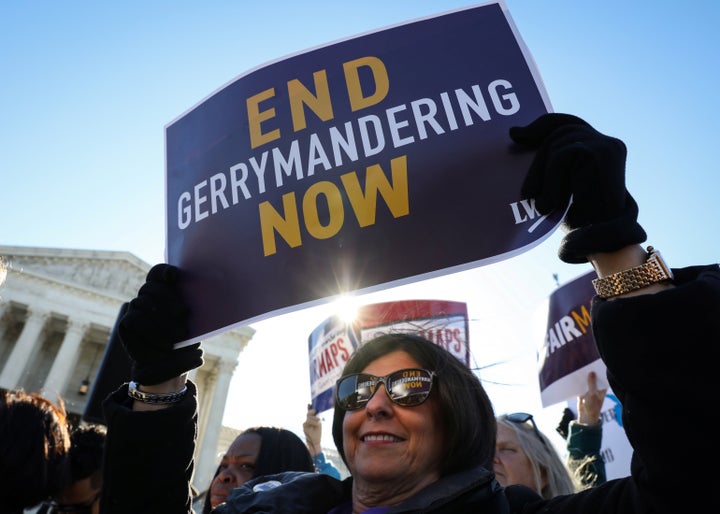Two years ago, Texas Rep. Dan Crenshaw sailed through his first reelection campaign without a problem: The freshman Republican, who in his first term embraced a tough-on-immigration persona and backed then-President Donald Trump’s border wall, ran unopposed in a GOP primary and then waltzed to a 13-point victory that November even in a district Trump barely won.
This go-round hasn’t been as smooth. Throughout a primary that will conclude on Tuesday, multiple Republican candidates have staked out positions well to Crenshaw’s right, no matter the fact that he ranks, by some measures, as one of the 50 most conservative members in the House GOP caucus.
To hear his opponents tell it, Crenshaw is the personification of Republican heresy: Although he supported a Texas lawsuit that sought to overturn the election in late 2020, Crenshaw has since denounced conspiracy theorists who said that the election was “stolen” from Trump. He’s also criticized the idea that sham audits, like those the Arizona GOP and Republicans elsewhere have conducted, will lead to Trump’s imminent return to the White House. “Republicans like Dan Crenshaw,” one of his right-wing challengers told The Texas Tribune recently, are “why we allowed ... the election to be stolen.”
Crenshaw still seems likely to emerge from the March 1 primary contest as his party’s nominee. But his primary plight offers one of the earliest glimpses into how the 2022 midterm elections are likely to push the party farther and farther to the right — and how the GOP’s approach to congressional redistricting is likely to exacerbate it.

Throughout the current redistricting cycle, Republicans have largely sought to shore up seats they already hold, by increasing the proportion of Republican voters in those districts, instead of creating new ones. And in Texas and elsewhere, their main targets have been seats like Crenshaw’s — districts that include substantial suburban areas that have trended, both demographically and politically, in favor of Democrats over the last decade. As in past rounds of redistricting, that approach is almost certain to dilute the votes of Black, Hispanic and other minority voters who have driven suburban population booms in Texas and other states.
But if that strategy was meant to protect incumbents like Crenshaw from Democrats (and Democratic constituencies) for the next decade, the hyper-conservative districts it has produced will also leave them far more vulnerable to challenges from their right. The inevitable result – aside from an even more heavily-skewed and significantly less competitive Congress overall – is the acceleration of the Republican Party’s march to the far right at a time when much of the GOP has already turned its back on American democracy.
“In places like Texas, Republicans drew maps like they felt they had to neutralize the suburbs,” said Michael Li, a gerrymandering and redistricting expert at the nonprofit Brennan Center for Justice. “That’s what Republicans did across the country: They created a lot of rural-suburban districts. They broke up the suburbs, and that’s going to affect the kinds of people that are elected.”
The GOP’s broad redistricting strategy was driven in large part by its own successes over the last decade. In heavily gerrymandered states like Texas, there weren’t many opportunities for Republicans to create new seats, at least not without putting other GOP districts at risk. Booming suburban populations — and the suburban political shift toward Democrats that began during the Obama presidency and exploded under Trump — also led Republicans to move their focus away from the urban centers that have long served as the target of their most aggressive gerrymanders.
Crenshaw’s district is one example: A decade ago, Texas Republicans gerrymandered the 2nd District to lump a swath of central Houston with northern Harris County to create the sort of district in which suburban and exurban voters, who largely favored the GOP at the time, would easily outnumber the area’s urban residents. It created a safe GOP seat north of a blue city, and Crenshaw filled it in 2018 after finishing second in a GOP primary and then winning a runoff.
In 2020, however, Trump carried the district by a single point, a margin narrow enough to drive Republican concerns about the coming decade, even though Crenshaw won easily. The new maps drafted and approved last year cut the urban piece of Houston out of the 2nd District entirely, and paired the remaining suburbs with a rural county that ranks as one of Texas’ Trumpiest locales. The result is a district Trump would have carried by 23 points, according to a University of Texas analysis.
Texas Republicans repeated the strategy across the state: In the 3rd Congressional District, a suburban Dallas seat held by GOP Rep. Van Taylor, they transformed a district that favored Trump by just one point in 2020 into one that would have handed the former president a 14-point victory.
The Texas GOP also sliced up Denton County, a northern Dallas suburb where Republican presidential margins shrunk from 31 points to just six from 2012 to 2020. For the last decade, Denton County has been split among the 24th and 26th Congressional Districts, but the new maps moved significant portions of its suburbs into the 13th District, a deep red seat held by Rep. Ronny Jackson.

Some Denton County residents will now vote in the same district as residents of Amarillo, more than 300 miles away — the district now stretches from the northern Dallas suburbs to the New Mexico border. By placing part of Denton County into Jackson’s district, which could safely absorb Democratic votes, Republicans made the 26th District slightly safer and ensured their dominance of the 24th: A district Trump lost by five points in 2020 would now favor him by 12 points.
As with Crenshaw, the changes have transformed districts and fueled conservative primary challenges. Taylor, an Iraq War veteran who voted both to certify the 2020 election results and in favor of the congressional commission to investigate the Jan. 6 insurrection, is now facing backlash from opponents who have turned the GOP primary into “a referendum on Jan. 6 and whether Trump really lost,” as The Dallas Morning News characterized it.
The Texas GOP’s efforts may be among the most obvious and aggressive, but Republicans have replicated the approach elsewhere. In Georgia, Republicans mixed traditional gerrymandering with the suburban-focused strategy, packing Atlanta’s increasingly Democratic northern suburbs into a single deep-blue district in order to create a new solidly Republican seat. The Tennessee GOP acted similarly, cracking Nashville — a city that has elected Democratic representatives continuously for more than a century — and its immediate suburbs into three districts guaranteed to elect Republicans.
Although the suburbs often code as white, wealthy and highly educated, the impact of the GOP’s attempts to gerrymander them will fall on familiar targets: Black, Latino and other minority voters who have long borne the brunt of efforts to draw district maps to produce predestined outcomes.
Racial and ethnic minorities have driven the nation’s population booms over the last decade, and suburban growth with it: Nationwide, there are now more Black, Latino and Asian Americans living in suburban communities than in the cities that have traditionally been the target of the most aggressive gerrymandering efforts. Texans of color were responsible for 95% of the state’s population growth since 2010, according to recent Census figures, and minority population growth has surged in the suburbs of Dallas, Houston, San Antonio and other major cities.
The same is true in Georgia, where Black, Latino and Asian voters have transformed the northern Atlanta suburbs that drove Democratic victories there in 2020 – and that became the target of the Georgia GOP’s gerrymanders.
The Department of Justice sued Texas in December, accusing its lawmakers of “refusing to recognize the state’s growing minority electorate” in drawing new maps ― both seats Texas gained in congressional reapportionment were drawn as majority-white districts, even though minorities had produced the population growth responsible for the new seats. The suit specifically cited a Dallas-area district in which the Justice Department alleged that Republicans had “surgically excised” Hispanic voters by melding suburban communities into a largely rural district.
But the federal government, which for a half-century has sought to protect minority communities from gerrymandering practices meant to significantly reduce their political power, now has little authority to correct state-driven efforts to disenfranchise those voters. Since the last round of redistricting, in 2011, conservative Supreme Court majorities have steadily gutted the Voting Rights Act of 1965, leaving Black, brown and other minority voters far more vulnerable to deliberate gerrymanders.
“This is just the obvious consequence,” said Alex Keena, a Virginia Commonwealth University professor who studies the effects of gerrymandering on political representation. “It’s basically legal now.”

Combined with the aggressive gerrymanders of a decade ago, the current round of redistricting is likely to create one of the least competitive congressional maps in American history: The makeup of Congress, ostensibly the most small-d democratic body of the federal government, has been largely preordained by mapmakers.
Just one of Texas’ 38 congressional districts is legitimately competitive now, according to Texas Monthly, after the GOP bolstered its margins in nine of the 10 most closely contested districts from the last cycle. Tennessee, where somewhere between 35 and 40% of the population routinely votes Democrat, won’t have a single competitive district. The trend filters to the state legislative level: In Georgia, only two of the state senate’s 56 districts, as drawn in new GOP maps, will have been decided by fewer than 10 percentage points in 2020’s presidential vote.
It’s impossible to make every district competitive, and efforts to reduce overall competition via gerrymandering are neither new nor Republicans’ alone. Democrats, fearing a GOP onslaught, heavily gerrymandered maps in several states they control, including New York, Illinois and Maryland.
But the overall situation skews the map heavily toward Republicans — even as it sought primarily to protect their existing majorities, the Texas GOP ensured that its share of the state’s congressional delegation would increase from 22 seats to a likely 25. And while Democrats have tried to rein in partisan gerrymandering via changes to federal law, the Senate GOP, along with Sens. Kyrsten Sinema (D-Ariz.) and Joe Manchin (D-W.V.a.), have refused to put an end to the practice.
The utter lack of competition that will result from gerrymandering and federal lawmakers’ inability (or unwillingness) to do anything about it is likely to have dire consequences for an already limping democracy. A legislature in which the vast majority of members are only accountable to a primary electorate, and can only lose to a member of their own party, is hardly democratic, and with the Republican Party already in the throes of Trumpist election conspiracies, its skepticism of the most fundamental tenets of democracy is likely to intensify.
Primaries like those facing Crenshaw and Taylor will become more common — the suburban Republican, already an endangered species, will become even rarer. Even those who do survive, as Crenshaw and Taylor seem likely to do for now, will likely have to move farther right to placate the party’s increasingly rabid base.
“You can see a world in which they become a little bit more conservative,” Li said. “Because they have to win the primary, and the primary electorates in these newly drawn districts are much more conservative.”

